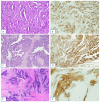Interobserver Agreement in Immunohistochemical Evaluation of Folate Receptor Alpha (FRα) in Ovarian Cancer: A Multicentre Study
- PMID: 40869006
- PMCID: PMC12387075
- DOI: 10.3390/ijms26167687
Interobserver Agreement in Immunohistochemical Evaluation of Folate Receptor Alpha (FRα) in Ovarian Cancer: A Multicentre Study
Abstract
Folate receptor alpha (FRα) is a high-affinity folate transporter overexpressed in various epithelial malignancies, particularly high-grade serous ovarian carcinoma. Given its restricted expression in normal tissues and accessibility in tumors, FRα is an emerging therapeutic target. Immunohistochemistry (IHC) is the standard method for FRα assessment; however, interpretation is semi-quantitative and prone to interobserver variability. This study aimed to evaluate interobserver agreement among 12 pathologists in the IHC assessment of FRα in ovarian cancer, focusing on internal control adequacy, staining intensity, and the percentage of FRα-positive tumor cells. Thirty-seven high-grade serous ovarian carcinoma cases were stained using the VENTANA FOLR1 (FOLR1-2.1) RxDx Assay. A reference panel of four expert pathologists established consensus diagnoses. Twelve pathologists independently assessed the slides, recording internal control adequacy, staining intensity (positive vs. negative), and percentage of FRα-positive tumor cells. Interobserver agreement was measured using Fleiss' kappa and intraclass correlation coefficient (ICC). Agreement on internal control adequacy was almost perfect (κ = 0.84). Substantial agreement was observed for staining intensity (κ = 0.76), while percentage estimation showed almost perfect concordance (ICC = 0.89). Discrepancies were primarily confined to borderline cases (65-85% positivity) and tumors with intermediate staining, reflecting interpretive challenges near clinical decision thresholds. Pathologists demonstrated high reproducibility in FRα IHC assessment, particularly in estimating percentage positivity and control adequacy. These findings support the clinical utility of FRα IHC but underscore the need for standardized scoring criteria and potential integration of digital tools to enhance consistency, especially in borderline cases.
Keywords: VENTANA FOLR1; folate receptor alpha; high-grade serous ovarian carcinoma; immunohistochemistry; ovarian cancer.
Conflict of interest statement
The authors declare no conflicts of interest.
Figures




Similar articles
-
Folate receptor alpha expression in low-grade serous ovarian cancer: Exploring new therapeutic possibilities.Gynecol Oncol. 2024 Sep;188:52-57. doi: 10.1016/j.ygyno.2024.06.008. Epub 2024 Jun 27. Gynecol Oncol. 2024. PMID: 38941962 Free PMC article.
-
Variation within and between digital pathology and light microscopy for the diagnosis of histopathology slides: blinded crossover comparison study.Health Technol Assess. 2025 Jul;29(30):1-75. doi: 10.3310/SPLK4325. Health Technol Assess. 2025. PMID: 40654002 Free PMC article.
-
Patient-reported outcomes from the MIRASOL trial evaluating mirvetuximab soravtansine versus chemotherapy in patients with folate receptor α-positive, platinum-resistant ovarian cancer: a randomised, open-label, phase 3 trial.Lancet Oncol. 2025 Apr;26(4):503-515. doi: 10.1016/S1470-2045(25)00021-X. Lancet Oncol. 2025. PMID: 40179908 Clinical Trial.
-
Folate Receptor Alpha in Advanced Epithelial Ovarian Cancer: Diagnostic Role and Therapeutic Implications of a Clinically Validated Biomarker.Int J Mol Sci. 2025 May 29;26(11):5222. doi: 10.3390/ijms26115222. Int J Mol Sci. 2025. PMID: 40508029 Free PMC article. Review.
-
Mirvetuximab soravtansine for the treatment of epithelial ovarian, fallopian tube, or primary peritoneal cancer.Future Oncol. 2025 Jul;21(17):2143-2153. doi: 10.1080/14796694.2025.2513848. Epub 2025 Jun 12. Future Oncol. 2025. PMID: 40501444 Free PMC article. Review.
References
-
- Webb P.M., Ibiebele T.I., Hughes M.C., Beesley J., van der Pols J.C., Chen X., Nagle C.M., Bain C.J., Chenevix-Trench G. The Australian Cancer Study (Ovarian Cancer) and the Australian Ovarian Cancer Study Group Folate and related micronutrients, folate-metabolising genes and risk of ovarian cancer. Eur. J. Clin. Nutr. 2011;65:1133–1140. doi: 10.1038/ejcn.2011.99. - DOI - PubMed
Publication types
MeSH terms
Substances
LinkOut - more resources
Full Text Sources
Medical

